Dell XPS 15 L521X: A Detailed First Look
by Jarred Walton on July 25, 2012 1:10 AM ESTDell XPS 15 Gaming Performance (with ThrottleStop)
This is where things get a bit messy and confusing. The CPU throttling on BIOS version A01 through A04 is a severe enough problem that out-of-box gaming performance on the XPS 15 is substantially lower than expected. In most games that we tested, CPU throttling kicks in after anywhere from 30 to 90 seconds, at which point the CPU sits at 1.2GHz until you exit the game. This makes benchmark results highly variable, with the first run always being the fastest, and frankly it’s unacceptable. How this slipped through the cracks on a shipping laptop is something of a mystery, as it took all of five minutes with DiRT 3 and Batman: Arkham City for me to determine something was wrong with performance, and to then track down the root cause. OEMs take note: both games have built-in benchmarks and your performance labs should be using these and other high-profile games to check performance before you start shipping product. End of discussion.
Now, with that out of the way, we wanted to see what the XPS 15 could do with a bit of fine tuning on CPU clocks. Under the default settings on the A04 BIOS, CPU temperatures topped out at 80C, which is lower than we’ve seen on quite a few laptops. Furthermore, CPU clocks were almost always 2.8GHz (maximum Turbo Boost for four threads or more on the i7-3612QM) before throttling down to 1.2GHz, which seems rather myopic. The whole point of Intel’s Turbo Boost is to let the CPU run at the maximum sustainable clock speed without overheating, and right now that’s not happening.
A bit of tinkering with ThrottleStop 5.0 Beta 3 yielded CPU temperatures in the 80-90C range with a 23X multiplier, with some games capable of running at 2.5 or even 2.6GHz without overheating. Again, this isn’t something an end user should be required to use in our opinion, but thankfully it does allow substantially improved performance and it’s easy enough to enable/disable as needed. Depending on the game in question, we saw performance improve by anywhere from 10% to over 100% by using a 23X multiplier with the CPU PROC HOT signal disabled—Batman and DiRT 3 showed the greatest improvements. Note also that the difference at higher quality settings isn’t as large, as the GPU becomes more of a bottleneck. We have 1080p “Enthusiast” results for the XPS 15 as well as our 768p “Value” and 900p “Mainstream” scores, but in most games 1080p Enthusiast wasn’t playable so we won’t report those scores for now. Let’s start with our Value and Mainstream results, and then we’ll list “recommended” settings and frame rates for the XPS 15 running at 1080p.
Value Gaming Performance
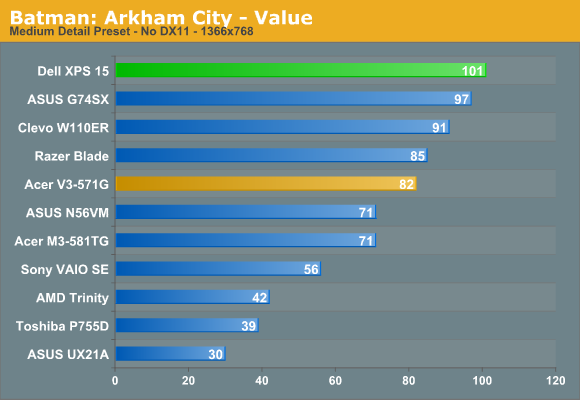

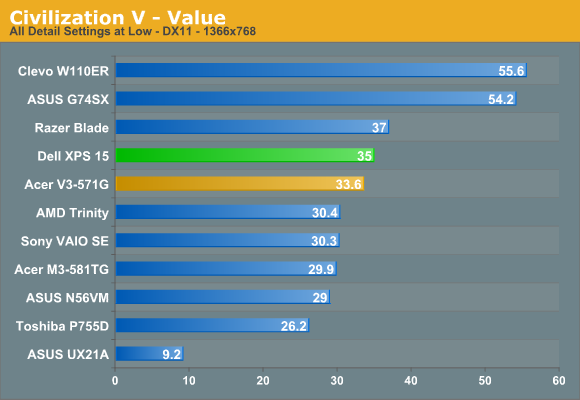

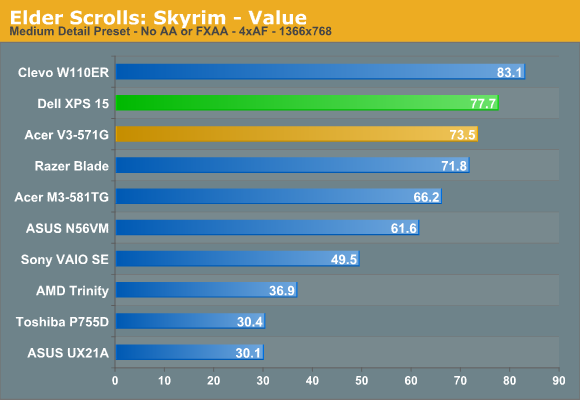
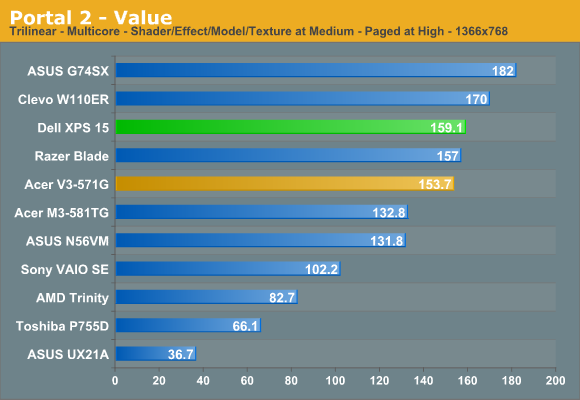
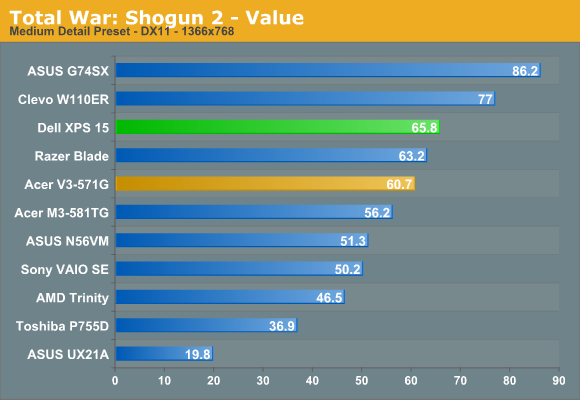
Our Value settings don’t pose any problem for the XPS 15, with all games easily besting 30FPS and most surpassing the 60FPS mark. The XPS 15 basically sweeps the table against the Acer V3, showing the value of using GDDR5 memory instead of DDR3 memory on the GPU. Also worth note is that Civilization V performance continues to be a bit quirky with certain driver versions; the original 296.01 drivers couldn’t even break 30FPS regardless of setting on the XPS 15, while the newer 304.79 beta drivers at least let you get 35FPS. One quick look at the W110ER results however shows that we ought to be able to get performance closer to 50FPS. I ran FRAPS while performing the Civ5 “lategameview” benchmark at one point to see what was going on, and for some reason performance appeared to fluctuate between 50FPS and 35FPS, where normally the frame rate is pretty steady. I’d guess a future NVIDIA driver will address the issue.
Mainstream Gaming Performance
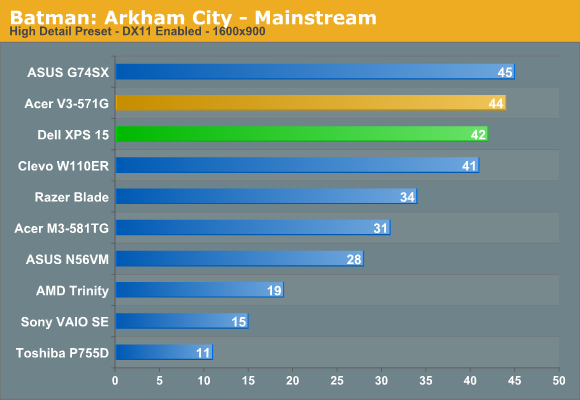
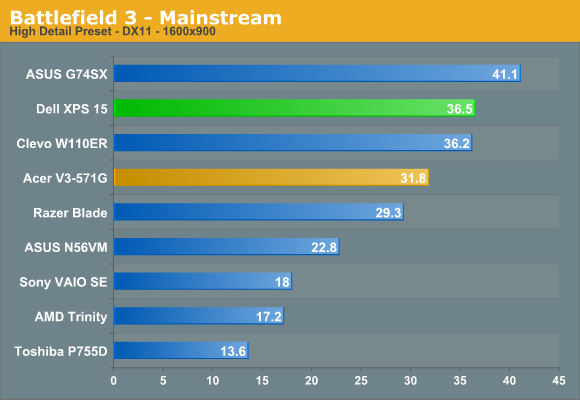
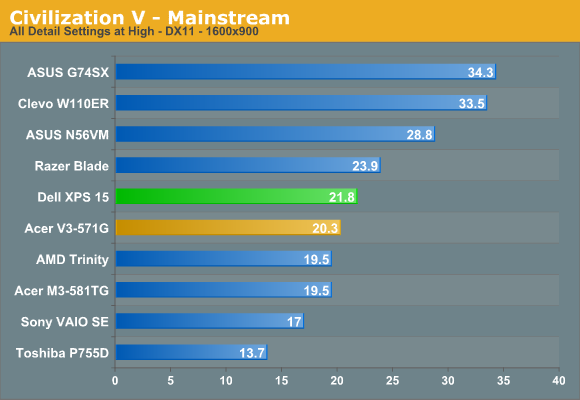
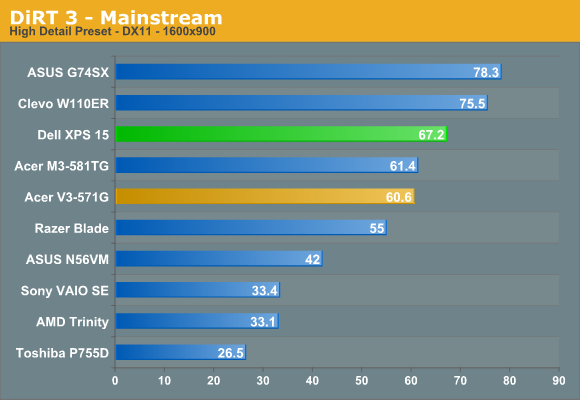
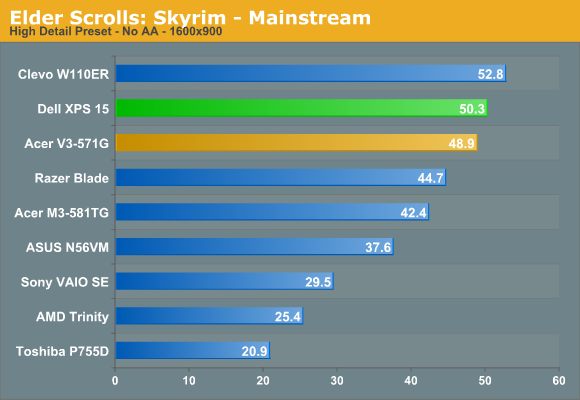
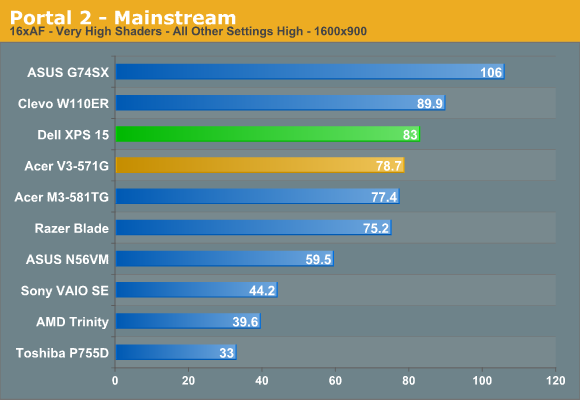

Mainstream performance generally follows the same pattern, only with lower frame rates. The GT 640M with GDDR5 is close to handling all of our test suite at 900p “High” details, with Battlefield 3 and Civilization V being the only two games where we’d recommend dropping to lower detail settings (and again, the drivers are likely a factor in Civ5 performance). It’s also interesting that the Acer V3 manages to eke out a win in Batman, indicating our lowered CPU clocks might be coming into play. Otherwise, the use of GDDR5 is typically able to improve GT 640M performance by an average of 8%, with up to 25% higher performance in at least one game (Batman using our Value settings).
|
Dell XPS 15 Gaming Recommended Settings for 1920x1080 |
|||
| Game | Detail | FPS | Notes |
| Batman: Arkham City |
Very High + 4xAA |
46 |
DX11 and PhysX both tend to be too much for the GT 640M, but you can max everything else out and maintain smooth frame rates. |
| Battlefield 3 |
Medium (“Value”) |
32.6 |
Single-player is okay at these settings, but multi-player will need to drop the resolution or use custom settings with some items on Low. |
| Civilization V | Low (“Value”) | 32.3 |
Civ5 needs a better driver, and we’ve seen higher scores in the past. Until then, setting everything to “Low” is your best bet for 1080p. |
| DiRT 3 | High + 4xAA | 45.8 |
Very fluid at the High defaults with 4xAA. If you try Ultra without AA, you’ll be closer to 30FPS. |
| Portal 2 | Max + 4xAA | 57.8 |
You can pretty much max out the settings in Portal 2 and still maintain fluid frame rates. |
| Skyrim | Ultra + 4xAA | 30.8 |
Skyrim is playable at 30FPS, and so our Enthusiast defaults work well enough. If you want slightly higher performance, you can use FXAA instead of 4xAA and get 35 FPS. |
| Total War: Shogun 2 |
High (“Mainstream”) |
34.8 |
The “High” preset seems to work best, though “Very High” with AA disabled is also viable. |
Most of the games’ settings are straightforward, but a couple warrant further explanation. In Batman, enabling Very High with PhysX is borderline playable, with an average frame rate of 27 FPS; DX11 without 4xAA is a similar 26 FPS, and enabling 4xAA in either mode drops a few FPS whereas FXAA is basically free. Civ5 performance is still a bit chaotic (see below), so take those scores with a grain of salt for now. Finally, our test scene in Skyrim happens to be one of the lowest performing areas we could find, so while we report 30 FPS there are many areas in the game that will run in excess of 60 FPS.
As mentioned earlier, Civilization V and Total War: Shogun 2 ran better with the most recent 304.79 beta drivers, and that’s what we used for the above settings. The remaining games all ran best with the official 296.01 Dell drivers, though at some point we expect to see a new WHQL driver that will provide the best of both worlds (and hopefully further improve Civ5 performance). Not shown in our charts is another popular game, Diablo III; given that the Acer V3 could handle maxed out settings, the same holds for the XPS 15. With GDDR5 memory, the GT 640M ends up being around 10% faster on average compared to DDR3; it can certainly handle gaming at 1080p, but in many games you’ll need to lower the detail settings somewhat to be fully playable.










109 Comments
View All Comments
ananduser - Wednesday, July 25, 2012 - link
Well your stress tests are against Anand's own review and many other reviews that have noticed how under long stress tests the MBP gets extremely hot. You're a lucky one.dtolios - Thursday, July 26, 2012 - link
Apple did nothing "new" with the rMBP...the contrary, it got thinner and the thermal envelope of the notebook got "tighter"...It's just that it is using "cooler" components that intel and nvidia put together.
The metal chassis can only insulate so much, and that is true for all manufacturers. Apple cannot beat physics (doh).
Thus really high end GPUs were always out of the question for MBPs, (and all thin/light laptops) despite the amount of money you were willing to throw in for customizing.
CeriseCogburn - Sunday, July 29, 2012 - link
Ha that is so funny to me - I can see that picky elite machead going for the totally silent room, doing the yoga meditation, some breathing exercises, then firing up the MBP to do some spiritual testing - getting that ear on down low next to it, to see if it can hold it's breath, too.That's why the macgineers had to do what they did do - it's the end user's magical idiot silent wet dream, and there are so many of those people... who cares if they burn their crotch off - that's a good thing.
Yeah, it's really sad. Same type of insanity with gaming gpus as they have the sound cranked to the max and often are wearing noise cancelling expensive headgear for sound. I suppose the fan sound would ruin their delicate and selective critical listening enjoyment.
name99 - Saturday, July 28, 2012 - link
The two are really not comparable. Read what Anand said:http://www.anandtech.com/show/6023/the-nextgen-mac...
The takeaways are:
- for many purposes attempting to stress the machine did NOT result in reduced performance
- even when it did, the falloff was not that extreme (5% or so)
- there was no mention of the system ever crashing due to thermal overload (and I've never heard of this in earlier Macbooks, eg my 2nd gen MBA very obviously throttles in hot weather, but it never crashes).
One thing I wonder (Anand hinted at the same thing) is whether this is a consequence of using a 45W part rather than 35W --- Apple has more headroom and is using that AS headroom, not as compute capacity. If so, this would be analogous to the way they under-clock pretty much every iOS device relative to the CPU's rated specs. The exact reasoning is slightly different, but the overall point is the same in both cases --- to balance the tangible, measurable goal of maximum performance against the intangible, unmeasurable goal of delight, where delight is increased by things like longer battery life, consistent performance and, of course, no crashes. The editorial aside would, of course, be that you can't build products that delight if you are purely driven by checklists and measured numbers --- you have to be willing to make tradeoffs, like leaving some performance on the table for the sake of battery life, or stability, or temperature.
[I'm not trying to be rah rah Apple here; I'm trying to point out the real differences between these two products, and the real factors that led to these differences.]
GotThumbs - Wednesday, July 25, 2012 - link
Ok Fanboi. Just remember the fact that Apple is now a PC Assembler. When they first came out...they built their own systems. They were not as successful back then. Now they use Intel chips and other PC components available to any other PC Assembler.Now Apple is a PC Assembler and they are very good at designing fashionable/attractive shells, but don't con your self into thinking Apple is a true innovator. The are very much like the Chinese in the 80's (Sony Tv's, Walkman, etc.). Apple is very good at taking an existing idea...and putting its own spin on it. There are features they have that are not mainstream...like fire-wire...but as the reviewer stated....He doesn't use it and most of the users of today are probably in the same boat. How great is an option or feature...in its not used/needed?
You need to put the Cool-Aid down.
Listen, If you like using Apples products and they do what you need....I'm happy for you. Just don't try and make this a pissing game or who's dad can beat up whose.
I'm really getting tired of the regurgitation of which is king.
Now that Apple is a PC assembler...the reviewers point about the OS is the key. Either you prefer windows or Apples OS.....or any other number of Linux alternatives.
All I'd like is for people to grow up and have a little respect for other peoples choices/decisions.
If it your money...spend it how you wish...but don't act like a 5 year old and sing about your ice-cream or whos king of the hill. It just too school yardish.
All the best and enjoy your computer.
solipsism - Wednesday, July 25, 2012 - link
1) So in 1976 when they first started out they were less successful than they are now as the world' largest publicly traded company? No fucking way! /s2) The parts they use today are more specialized then any other time in Apple's history. Using an Intel processor doesn't change anything as the processors they used previously were also available to others. Just look at the Xbox 360 for proof.
3) Also note that Apple builds their ARM SoCs based on reference designs. Same goes for a lot of other components that Apple doesn't directly own but has invested heavily in and therefore has been given exclusive rights for a set period of time. Their display tech for the iPhone, iPad and now MBP come to mind.
kevith - Wednesday, July 25, 2012 - link
I´l just second your opinion of the pissing contest.And this isn´t even a Mac-review...
CeriseCogburn - Sunday, July 29, 2012 - link
Oh come on, we've got to compare. I'm learning here. Let them express.xype - Wednesday, July 25, 2012 - link
…and Apple was the first to figure it out, it seems.At least Dell made the keyboard area black and put the sleep light in the center, that counts for something, amirite?
It’s kind of weird that Apple’s "think different" is becoming a "everyone be like Apple!". I love my MacBook Pro and iPad, but damn, it would feel nice to see an original design on the (big vendor) PC side now and then.
Why do these companies think people will buy a copy of an Apple design/hardware, if they can get the original just as well? Customers like choice, yes, but choice does not mean 5 vendors making the same laptop all over again.
No wonder the PC makers are struggling, they’re all lead by unimaginative MBA retards.
ananduser - Wednesday, July 25, 2012 - link
Yes PC makers are indeed struggling, Apple being one of them. Apple's PC lineup is also not the pinnacle of mobile computing. Get a grip.